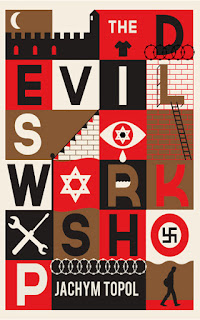Appropriately, the book's amazing cover (designed by Bobby Evans at Telegramme Studio) was featured yesterday by the Casual Optimist (Dan Wagstaff).
 |
| Cover of The Devil's Workshop Bobby Evans/Telegramme Studio |
He picked it up from Jemima at Jackie Magpie, who had this to say about it:
High five, Portobello – a double whammy on this week’s Book by its Cover! Designed by Bobby Evans of Telegramme Studios, this cover is quite dark and masculine; miles away from the flowing, whimsical cover of The Emperor of Paris. I love the bold and busy geometric design and the way you have to work to read the title (nosy people on the Tube will probably think you’re reading ‘Evil Work Shoe’). It’s clever and eye-catching – a winner in my book!There's a story about the design, though, that I've held off on sharing till now: I got my first look at the cover in January 2012, while I was still working on the translation. Originally, there was no hammer-and-sickle, and the square just above the walking man in the lower right-hand corner contained a swastika:
 |
| Original cover of The Devil's Workshop Bobby Evans/Telegramme Studio |
As I wrote Philip Gwyn Jones, the director and publisher of Portobello Books:
The cover looks great! My only concern is that, crime-wise, the novel is as much about the Soviets as it is about the Nazis, so it seems unfair that there's a swastika but no hammer-and-sickle. This is tremendously important, because we in "the West" still have a much stronger moral stand against the crimes of Nazism than the crimes of Soviet communism, and as Timothy Snyder's book Bloodlands made devastatingly clear (my fantasy, actually, is to have Tim do a foreword for Jáchym's novel), in this part of Europe, for Jews and non-Jews alike, the killing came hard and heavy from both sides, sometimes in alternation and sometimes all at once. This is something people in Czechoslovakia, people probably in most of the former Soviet bloc, have known all along, but it's only just beginning to sink in for us. That's my two cents.In the end, the swastika had to be replaced for legal reasons, since many countries in Europe wouldn't have allowed the book to be displayed in shops if it had a swastika on the cover. In any case, the SS runes are an excellent substitute.
Now I'm just looking forward to reading reviews of what's inside the book.
* I'll be honest and say it didn't occur to me till today that the date — 6/6/13 — might be interpreted as having some connection to the novel's title or subject matter. But it doesn't; it just worked out that way.

No comments:
Post a Comment